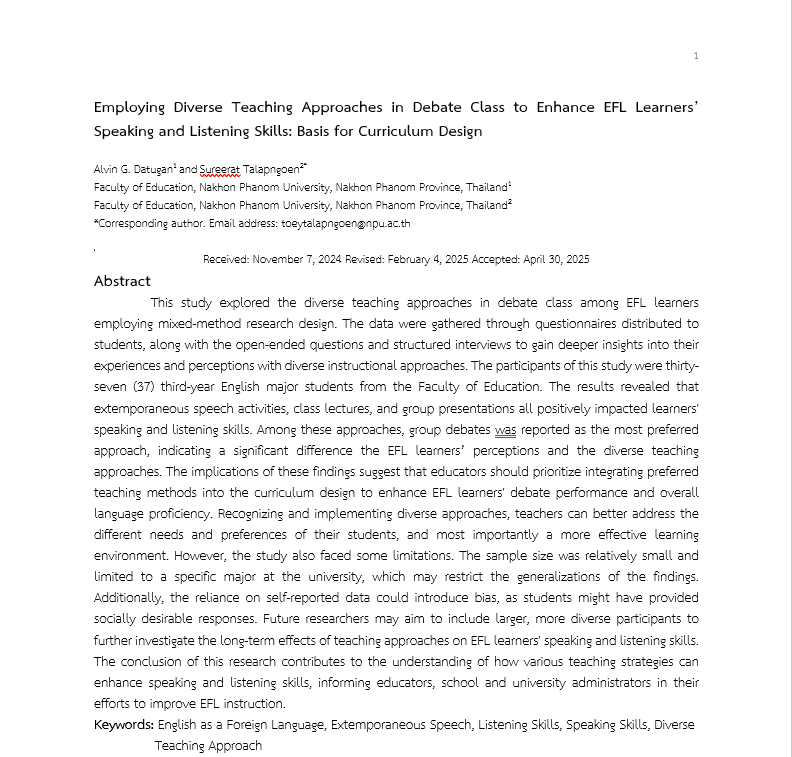Employing Diverse Teaching Approaches to Enhance EFL Learners' Speaking and Listening Skills: Basis for Curriculum Design
Main Article Content
บทคัดย่อ
This study explored the diverse teaching approaches in debate class among EFL learners employing mixed-method research design. The data were gathered through questionnaires distributed to students, along with the open-ended questions and structured interviews to gain deeper insights into their experiences and perceptions with diverse instructional approaches. The participants of this study were thirty-seven (37) third-year English major students from the Faculty of Education. The results revealed that extemporaneous speech activities, class lectures, and group presentations all positively impacted learners' speaking and listening skills. Among these approaches, group debates was reported as the most preferred approach, indicating a significant difference the EFL learners’ perceptions and the diverse teaching approaches. The implications of these findings suggest that educators should prioritize integrating preferred teaching methods into the curriculum design to enhance EFL learners' debate performance and overall language proficiency. Recognizing and implementing diverse approaches, teachers can better address the different needs and preferences of their students, and most importantly a more effective learning environment. However, the study also faced some limitations. The sample size was relatively small and limited to a specific major at the university, which may restrict the generalizations of the findings. Additionally, the reliance on self-reported data could introduce bias, as students might have provided socially desirable responses. Future researchers may aim to include larger, more diverse participants to further investigate the long-term effects of teaching approaches on EFL learners' speaking and listening skills. The conclusion of this research contributes to the understanding of how various teaching strategies can enhance speaking and listening skills, informing educators, school and university administrators in their efforts to improve EFL instruction.
Article Details

อนุญาตภายใต้เงื่อนไข Creative Commons Attribution-NonCommercial-NoDerivatives 4.0 International License.
บทความที่ได้รับการตีพิมพ์เป็นลิขสิทธิ์ของวารสารครุศาสตร์ คณะครุศาสตร์ มหาวิทยาลัยนครพนม ข้อความที่ปรากฏในบทความแต่ละเรื่องในวารสารครุศาสตร์เล่มนี้เป็นความคิดเห็นส่วนตัวของผู้เขียนแต่ละท่านไม่เกี่ยวข้องกับมหาวิทยาลัยนครพนม และคณาจารย์ท่านอื่น ๆ ในมหาวิทยาลัยฯ แต่อย่างใด ความรับผิดชอบองค์ประกอบทั้งหมดของบทความแต่ละเรื่องเป็นของผู้เขียนแต่ละท่าน หากมีความผิดพลาดใด ๆ ผู้เขียนแต่ละท่านจะรับผิดชอบบทความของตนเองแต่ผู้เดียว
เอกสารอ้างอิง
Ambele, E. A., & Boonsuk, Y. (2020). Voices of learners in Thai ELT classrooms: A wake-up call towards teaching English as a lingua franca. Asian Englishes, 23(2), 201–217. https://doi.org/10.1080/13488678.2020.1759248
Basic Education Core Curriculum B.E. 2551 (A.D. 2008).
Creswell, J. W., & Poth, C. N. (2016). Qualitative inquiry and research design: Choosing among five approaches. Sage publications.
Datugan, A. G. (2024). Analysis of EFL learners’ attitudes towards Communicative Language Teaching (CLT) approach and its impact on their academic performance. International Journal of Research and Innovation in Social Science, 8(8), 3456-3462.
Dehham, S. H., Bairamani, H. K., & Shreeb, A. (2021). Enhancing Iraqi EFL preparatory school students’ speaking skill by using debate technique. Turkish Journal of Computer and Mathematics Education, 12(7), 3189-3196. https://www.proquest.com/scholarly-journals/enhancing-iraqi-efl-preparatory-school-students/docview/2623612933/se-2
Eisenberg, M. (2015). The power of effective communication in education. Educational Leadership, 73(4), 60-63.
Fitzgerald, J. W., & Posner, M. I. (2021). Experiential learning in language education: Bridging theory and practice. Journal of Language Teaching and Research, 12(1), 123-132.
Intraboonsom, C., Darasawang, P., & Reinders, H. (2020). Teacher’s practices in fostering learner autonomy in a Thai university context. Journal of Language Teaching and Research, 11(2), 194+. http://dx.doi.org/10.17507/jltr.1102.07
Kirst, T., Chaisiri, P., Chantaruchikapong, N., & Wilang, J. D. (2023). Communication strategies used by ASEAN undergraduate students in the ELF setting. Journal of Mekong Societies, 19(3), 109–131. https://so03.tci-thaijo.org/index.php/mekongjournal/article/view/264923
Kongkerd, W. (2013). Teaching English in the era of English used as a lingua franca in Thailand. Executive Journal, 33(4), 3-12.
Liu, M., & Littlewood, W. (2019). Why do learners want to learn a second language? International Journal of Language Studies, 13(3), 17-34.
McNaughton, S. (2016). Collaborative learning: The role of peer interactions in the development of language skills. Language Learning & Technology, 20(2), 112-127.
Microsoft Corporation. (2018). Microsoft Excel. Retrieved from https://office.microsoft.com/excel
The jamovi project. (2022). jamovi. (Version 2.3) [Computer Software]. Retrieved from https://www.jamovi.org
Zhang, D., Zhao, J., Zhou, L., & Nunamaker, J. F. (2021). Can e-learning replace classroom learning? Communications of the ACM, 64(5), 28-30.

